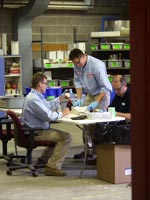
Chemical Continuum
Labs need to plan for proper hazardous materials storage and waste disposal from the outset
 Industrial research labs often manage chemical and hazardous waste storage and removal separately, using different contractors at various points in the handling process.
Industrial research labs often manage chemical and hazardous waste storage and removal separately, using different contractors at various points in the handling process.
An outside contractor might deliver chemicals from inventory to the researchers; the researchers may deliver waste chemicals to Satellite Accumulation Areas (SAA); another outside contractor could move the waste materials from the SAA to the Main Storage Area (MSA); and finally, a third company would characterize and pack the chemicals for shipment and dispose of them. While this process looks good on paper, in my experience, about half of the containers cannot be accepted by the disposal company because of labeling issues and unknown contents. These containers then must be returned to the researchers for verification and labeling and then sent back to the MSA.
Clearly, this approach is inefficient in terms of time, safety, and cost. Control needs to start at the outset: Hazardous materials management has to be a continuum that begins before the chemicals arrive at the lab through disposal.
An effective waste management program, which conforms to U.S. Environmental Protection Agency Resource Conservation and Recovery Act (RCRA) regulations, requires a comprehensive site-specific waste management plan, organized and secured SAA and MSA locations, and ongoing staff training.
Some of the issues and recommended best practices for chemical management and storage include the following:
• Outdated chemicals are the most common problem. Causes include over ordering, abandoned chemicals, multiple containers in inventory for the same chemical, and failure to use the oldest container first. Some of this is related to the funding for different research grants, cost center accounting, and other administrative issues. Generally, the best approach is to centralize purchasing and inventory management and to buy the correct amount for all uses. Dispensing can then be made from the containers with the closest expiration dates, and the cost allocations can be handled administratively.
• Non-existent or improperly labeled chemicals in secondary containers are often due to simple negligence on the part of researchers, but they start a potentially dangerous and costly chain of events. This is a frequent cause of Notice of Violation (NOV) citations and often the result of lax management and infrequent refresher training. The researcher knows what is in the container, but if he or she leaves the area without properly identifying materials, even cleaning agents or isopropyl alcohol, the container contents must be treated as an unknown substance, which may require testing, special handling, and disposal. The best practice is to immediately label all secondary containers in accordance with hazardous communication (HAZCOM) training regulations with the full chemical name (not just the symbol). Some labs use preprinted labels available at the point of dispersal to facilitate this practice. Others use barcodes with human-readable text to facilitate handling and accommodate digital tracking systems.
• Waste containers in SAAs and MSAs must be labeled with the class of chemicals in the container. The most effective labels actually list every specific chemical in the lab’s inventory that can be added to the container. This provides another level of verification and eliminates unexpected reactions between seemingly compatible materials.
• Every location that stores waste chemicals can be considered an SAA by regulators and is subject to inspection. In many labs, each researcher keeps a personal SAA at his or her own workstation. At these sites, storage techniques, both in terms of segregating chemicals and ensuring that all containers are properly closed between pour-offs, tend to be casual. I’ve seen many NOVs in relation to casual SAAs. It makes sense to minimize the number of storage areas by positioning them in convenient locations to serve several researchers.
• Many labs do not have regular waste pick-up schedules for moving materials to the MSA. This can be disruptive to researchers and requires that a person authorized to enter the MSA be on-call. Scheduled removals facilitate smooth lab operations. An added benefit is that, with a regular schedule and process, the person handling the scheduled move can show up with the proper replacement container further expediting the process. The person removing the container can make sure that the new container is properly positioned with compatible materials and within secondary containers. An orderly removal process minimizes the number of people who require access to the MSA, which reduces the need for training.
• Segregating waste by some logic -- such as Department of Transportation (DOT) groupings, disposal company preferences, or some other criterion -- facilitates packaging and disposal. This simplifies handling and reduces errors. Again, regularly scheduled pickups of MSA materials will help meet 90-day limits and avoid work disruptions. Last-minute calls for pickup can substantially add to disposal costs.
Chemical and hazardous waste materials storage is a basic part of effective and compliant lab management. The challenge is to reduce errors by instituting and enforcing consistent, effective practices. There are online and software tools that facilitate full lifecycle tracking, managing, and reporting of lab materials.
Researchers should be allowed to concentrate on their work. Waste handling should be consolidated with a limited number of internal staff who handle the whole process or outsourced to a company that specializes in handling hazardous materials from inventory to disposal.
About the Author
Elizabeth G. Peterson is vice president, Apollo Onsite Services for Clean Harbors Environmental Services, Inc. Her 18-year career at the company includes both operations management and business development responsibilities. To contact Peterson, call 336.361.6158.